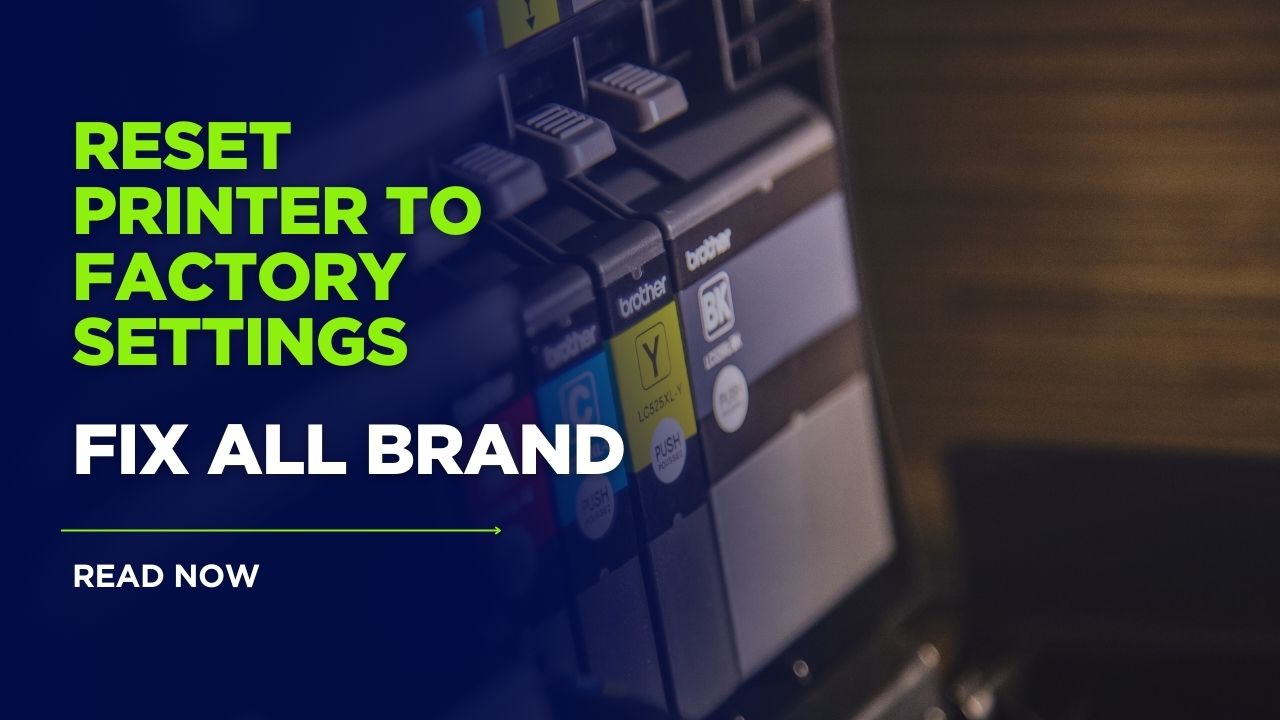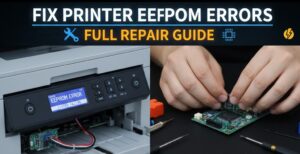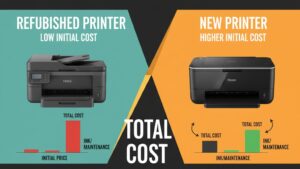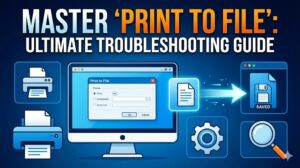Introduction
When you need to reset printer to factory settings, finding the right procedure for your specific brand and model can be challenging. Whether you’re troubleshooting persistent errors, preparing your printer for resale, or simply starting fresh after configuration problems, a factory reset can resolve many common printer issues. This comprehensive guide walks you through the reset process for all major printer brands including HP, Canon, Epson, and Brother. We’ll cover both basic and advanced reset methods, explain when a factory reset is appropriate, and provide troubleshooting tips for when things don’t go as planned. By following these manufacturer-specific instructions, you can successfully restore your printer to its original settings without the frustration of trial and error.
What Is a Printer Factory Reset?
A factory reset for a printer is a troubleshooting procedure that restores the device to its original manufacturer settings, effectively erasing all personalized configurations, network information, and stored data. This process returns the printer to the same state it was in when you first removed it from the box, eliminating any software-related issues that may have developed over time.
During a factory reset, the following elements typically get cleared or restored:
- Network settings and saved Wi-Fi credentials
- Print preferences and default settings
- Stored print jobs and document history
- User accounts and authentication settings
- Custom paper sizes and media configurations
- Firmware modifications (though the current firmware version usually remains)
- Language and regional settings
- Stored fax numbers and fax settings (for multifunction devices)
It’s important to understand that a factory reset differs from a simple printer restart or a settings refresh. While these lighter interventions might solve temporary issues, a factory reset is a more comprehensive solution that addresses deeply embedded configuration problems. Think of it as the difference between restarting your smartphone versus completely erasing it and starting over—the latter is more thorough but requires more setup afterward.
8 Ways to Reset Printer to Factory Settings by Brand

1. How to Reset HP Printers to Factory Settings
HP printers offer several reset methods depending on your model and the specific problem you’re facing.
For HP Inkjet Printers:
Step-by-step process:
- Ensure your printer is powered on and in a ready state
- Press and hold the “Power” button on your printer
- While holding the Power button, press the “Cancel” button (usually marked with an X) three times
- Release the Power button
- Wait for the printer to enter maintenance mode (the display may show “0” or special characters)
- Press the “Cancel” button repeatedly until you see “Semi-Full Reset” or “Cold Reset” on the display
- Press the “Start” or “Resume” button to confirm
- Wait for the reset process to complete (the printer will restart automatically)
- When prompted, select your language and country/region preferences
For HP LaserJet Printers:
Step-by-step process:
- Turn off the printer completely
- Press and hold the “Go” or “Resume” button (sometimes labeled with a checkmark)
- While holding this button, turn on the printer
- Continue holding the button until all three lights (Ready, Data, and Attention) are illuminated
- Release the button
- On the control panel, navigate to “Service” or “Settings” menu
- Select “Restore Defaults” or “Factory Reset”
- Confirm your selection when prompted
- Allow the printer to restart and complete initialization
For HP printers with touchscreen displays, the process is even simpler. Navigate to “Setup” or “Settings,” then “Printer Maintenance” or “Tools,” and look for “Restore Defaults” or “Factory Reset” option. Follow the on-screen prompts to complete the reset.
You can find additional information about specific HP printer models on the official HP Support website.
2. How to Reset Canon Printers to Factory Settings
Canon printers have different reset procedures depending on whether they’re inkjet or laser models.
For Canon PIXMA Inkjet Printers:
Step-by-step process:
- Turn off your Canon printer
- Press and hold the “Stop/Reset” button
- While holding this button, press and hold the “Power” button
- Continue holding the Power button but release the Stop/Reset button
- Press the Stop/Reset button 2 times while still holding the Power button
- Release all buttons
- The printer will display a message or special characters indicating it’s in reset mode
- Use the + or – buttons to navigate to “Factory Reset” or “Device Settings”
- Press “OK” or “Select” button
- Choose “Yes” when asked to confirm the reset
- Wait for the printer to restart with factory settings restored
For Canon ImageCLASS Laser Printers:
Step-by-step process:
- On the printer control panel, press “Menu” or “Settings”
- Navigate to “Setup” or “Device Settings”
- Select “Reset” or “Initialization”
- Choose “Reset All” or “Factory Defaults”
- Press “Yes” or “OK” when prompted to confirm
- Enter the administrator password if requested (default is often “0000” or “1234”)
- Wait for the reset to complete and the printer to restart
- Set up your language and region when prompted
Canon MegaTank and professional series printers may have slightly different menu options, but the general navigation pattern remains similar—look for settings, maintenance, or device options followed by reset or initialization choices.
3. How to Reset Epson Printers to Factory Settings
Epson printers offer multiple reset options depending on the severity of the issue you’re experiencing.
For Epson EcoTank and WorkForce Printers:
Step-by-step process:
- Turn off your Epson printer
- Press and hold the “Reset” or “Stop” button (usually marked with a red triangle or X)
- While holding this button, press and hold the “Power” button
- Continue holding both buttons for 5-10 seconds
- Release the Power button first, then the Reset button
- The printer should enter recovery or maintenance mode
- Use the arrow keys to navigate to “Factory Reset” or “Restore Default Settings”
- Press “OK” or “Select” to confirm
- Choose “Yes” when asked to confirm the reset
- Wait for the reset process to complete and the printer to restart
For Epson Expression and SureColor Printers:
Step-by-step process:
- From the home screen or main menu, press “Setup” or “Settings”
- Navigate to “Restore Default Settings” or “Administration”
- Select “Restore Factory Settings” or “All Settings”
- Press “Yes” when asked to confirm
- For some models, you may need to select which settings to reset:
- Network Settings
- Print Settings
- All Settings (choose this for complete factory reset)
- Wait for the printer to process the request and restart
For Epson printers with network connectivity problems, you can also reset just the network settings by locating the small reset button (usually on the back or under a panel) and pressing it with a paperclip for 10-15 seconds until the network light flashes.
4. How to Reset Brother Printers to Factory Settings
Brother printers typically offer both partial and complete reset options through the control panel.
For Brother Inkjet Printers:
Step-by-step process:
- Press the “Menu” button on your printer
- Use the arrow keys to navigate to “Initial Setup” or “General Setup”
- Press “OK” or “Select”
- Navigate to “Reset” and press “OK”
- Choose one of the following options:
- “Network” (resets only network settings)
- “All Settings” (complete factory reset)
- Press “Yes” to confirm
- Press “Yes” again when asked “Reboot OK?”
- Wait for the printer to restart with factory settings restored
For Brother Laser Printers:
Step-by-step process:
- Press “Menu” or “Settings” on the control panel
- Navigate to “General Setup” or “Initial Setup”
- Select “Reset”
- Choose from the following options:
- “Network” (for connectivity issues only)
- “Factory Reset” or “All Settings” (for complete reset)
- Press “Yes” or “1” when prompted to confirm
- For network reset, select “Yes” or “1” for reboot
- For factory reset, select “Reset” and then “Yes” for reboot
- The printer will restart and return to factory default configuration
Brother professional series and multifunction printers may require an administrator password before performing a factory reset. The default password is typically “access” or “initpass,” but check your printer’s documentation if these don’t work.
5. How to Reset Lexmark Printers to Factory Settings
Lexmark printers offer straightforward reset options through their menu systems.
Step-by-step process:
- From the printer’s home screen, touch “Settings” or press the Menu button
- Navigate to “Device” or “General Settings”
- Select “Restore Factory Defaults” or “Factory Defaults”
- Choose one of the following options:
- “Restore Settings” (keeps network/server settings)
- “Restore All Settings” (complete factory reset)
- Touch “RESTORE” or “Yes” to confirm
- The printer will restart automatically
- After restart, follow the initial setup prompts
For older Lexmark models without touchscreens, use the arrow buttons to navigate to “Settings,” then “General Settings,” followed by “Factory Defaults” and “Restore Now.”
6. How to Reset Xerox Printers to Factory Settings
Xerox printers and multifunction devices provide reset options through their sophisticated control panels.
Step-by-step process:
- Press the “Machine Status” button on the control panel
- Touch the “Tools” tab or select “Tools” from the menu
- Select “Device Settings” or “System Settings”
- Touch “Common Settings” or “General”
- Select “Maintenance” or “Reset”
- Choose “Reset All Settings” or “Clear All Data and Settings”
- Touch “Reset” or “Start” when prompted
- Enter the administrator password if requested (default is often “1111” or “admin”)
- Confirm by selecting “Yes” or “Continue”
- Allow the printer to restart and complete the initialization process
For network-only resets on Xerox printers, navigate to Tools > Network Settings > Reset Network Settings instead of performing a complete factory reset.
7. How to Reset Dell Printers to Factory Settings
Dell printers typically provide reset options through the operator panel menu system.
Step-by-step process:
- Press “Menu” on the printer control panel
- Use arrow keys to navigate to “Admin Menu” or “Settings”
- Select “Factory Defaults” or “Reset Settings”
- Choose one of the following:
- “Reset” (keeps network settings)
- “Reset All” (complete factory reset)
- Press “Yes” or “Continue” to confirm
- The printer will restart automatically
- Set up language and region preferences when prompted
For some Dell laser printers, you can also perform a reset by turning off the printer, holding down the “Cancel” and “>” (forward) buttons simultaneously, and then turning the printer on while continuing to hold these buttons until “Performing Self Test” appears on the display.
8. How to Reset Samsung Printers to Factory Settings
Although Samsung’s printer division was acquired by HP, many Samsung printers are still in use and have their own reset procedures.
Step-by-step process:
- On the printer control panel, press “Menu” or navigate to “Settings”
- Select “System Setup” or “Initial Setup”
- Navigate to “Clear Setting” or “Maintenance”
- Select “Reset Settings” or “All Settings”
- Press “Yes” when asked to confirm
- Enter the admin password if prompted (default is often “admin” or “1234”)
- The printer will automatically restart
- Complete the initial setup process when prompted
For Samsung multifunction printers with touchscreens, tap “Settings” > “Management” > “General” > “Reset Settings” > “All Settings” > “Reset” > “Yes.”
Additional Tools and Methods for Printer Resets
Beyond the standard factory reset procedures outlined above, several alternative methods can help address specific printer issues:
Web Interface Reset: Most network-connected printers offer a web-based administration interface accessible by typing the printer’s IP address into a web browser. Look for “Maintenance,” “Troubleshooting,” or “Administration” sections, which often include reset options not available through the physical control panel. This method is particularly useful for printers with limited display capabilities or when the control panel is malfunctioning.
Mobile App Resets: Manufacturer apps like HP Smart, Canon PRINT, Epson iPrint, and Brother iPrint&Scan often include maintenance and reset functions. These apps can be especially helpful for home printers without extensive control panels. Look for “Maintenance,” “Printer Settings,” or “Advanced Settings” within these applications to find reset options.
Service Mode Access: Many printers have hidden service or maintenance modes accessible through specific button combinations. These modes often provide more thorough reset options than those available in standard menus but should be used cautiously as they may affect calibration settings. Manufacturer service manuals (often available online) provide the specific button sequences needed for your model.
Firmware Restoration: For printers experiencing severe software issues, reinstalling or updating the firmware can provide a reset-like effect while also applying the latest improvements and bug fixes. Most manufacturers offer firmware download tools on their support websites, along with detailed installation instructions specific to each model.
Common Problems and Troubleshooting During Factory Resets
Even factory reset procedures can encounter complications. Here are solutions to the most common issues that arise during the reset process:
Printer Doesn’t Enter Reset Mode: If your printer doesn’t respond to the reset button sequence, try powering off the printer completely, unplugging it for at least 60 seconds, and then reconnecting it before attempting the reset sequence again. For persistent issues, check if there’s a firmware update available for your model, as outdated firmware can sometimes prevent proper reset functions.
Reset Appears Incomplete: Sometimes a factory reset appears to complete but some settings remain unchanged. In these cases, perform a secondary reset focused specifically on the problematic settings area (network, print settings, etc.). For network issues that persist after a general reset, locate the dedicated network reset button (usually a small recessed button requiring a paperclip) and hold it for 10-15 seconds.
Printer Stuck in Boot Loop After Reset: If your printer continuously restarts after a reset attempt, interrupt the power during restart (unplug it), then press and hold the cancel or stop button while reconnecting power and turning it on. This often breaks the loop and allows normal startup. If this doesn’t work, you may need to perform a firmware recovery or reinstallation using the manufacturer’s support tools.
Lost Connectivity After Reset: Remember that a factory reset erases all network settings, requiring you to reconfigure Wi-Fi connections, IP addresses, and security settings. For wireless printers, you’ll need to reconnect to your network using either WPS, the printer’s control panel, or a temporary USB connection and setup software. For wired network printers, you may need to reconfigure static IP settings if your network doesn’t use DHCP.
Error Messages During Reset Process: If you encounter specific error codes during the reset process, consult your printer’s manual or the manufacturer’s support website for code-specific troubleshooting. Common reset-related errors include:
- Memory error (usually resolved by powering off completely before resetting)
- Component error (may indicate hardware issues beyond reset capabilities)
- Timeout error (typically fixed by ensuring the printer is idle before starting the reset)
Reset Doesn’t Solve Original Problem: If your printer still exhibits the same issues after a successful factory reset, the problem may be hardware-related rather than configuration-based. Check for paper jams, worn components, low ink/toner warnings, or connection problems. Physical inspection of printer components may be necessary to identify mechanical failures that reset procedures cannot address.
Frequently Asked Questions
Will resetting my printer to factory settings delete saved documents or scans?
Yes, resetting your printer to factory settings will delete any documents, scans, or faxes stored in the printer’s internal memory. If these files are important, transfer them to your computer before performing a factory reset. This applies particularly to multifunction printers with document storage capabilities and devices with internal hard drives or significant onboard storage.
Do I need to reinstall printer drivers after a factory reset?
In most cases, you don’t need to reinstall printer drivers on your computer after resetting the printer to factory settings. The reset affects only the printer’s internal settings, not the software installed on connected computers. However, you will need to reconnect the printer to your network and possibly reconfigure any custom print settings you previously established.
How do I know if my printer reset was successful?
A successful factory reset typically results in the printer restarting and displaying initial setup prompts similar to when it was new. You’ll likely be asked to select language preferences, region settings, and connection options. Additionally, any personalized settings like custom paper sizes, print quality defaults, or network names should return to their original manufacturer values.
How often should I reset my printer to factory settings?
Factory resets should be performed sparingly and only as a troubleshooting measure when other solutions have failed. Common situations warranting a reset include persistent error messages that standard troubleshooting can’t resolve, connectivity problems that remain after network troubleshooting, or preparing the printer for sale or transfer to another user. Regular maintenance like cleaning and software updates is preferable to frequent resets.
Conclusion
Knowing how to reset printer to factory settings is an essential troubleshooting skill that can resolve many common printer issues when other methods fail. The process varies significantly across brands and models, but the general approach involves accessing maintenance or settings menus and selecting reset options. Remember that a factory reset should be considered a last resort after trying more targeted troubleshooting steps, as it will erase all your customized settings and require some reconfiguration afterward.
Before performing a reset, always document your current network settings and print preferences to make restoration easier. For networked printers in business environments, consider consulting with your IT department before proceeding with a factory reset, as it may affect shared configurations and access controls. With the step-by-step instructions provided in this guide, you can confidently reset your printer when necessary, restoring it to optimal functionality and resolving persistent software-related issues.
Why Does My Printer Restarts Automatically? Read More.





Recent Comments